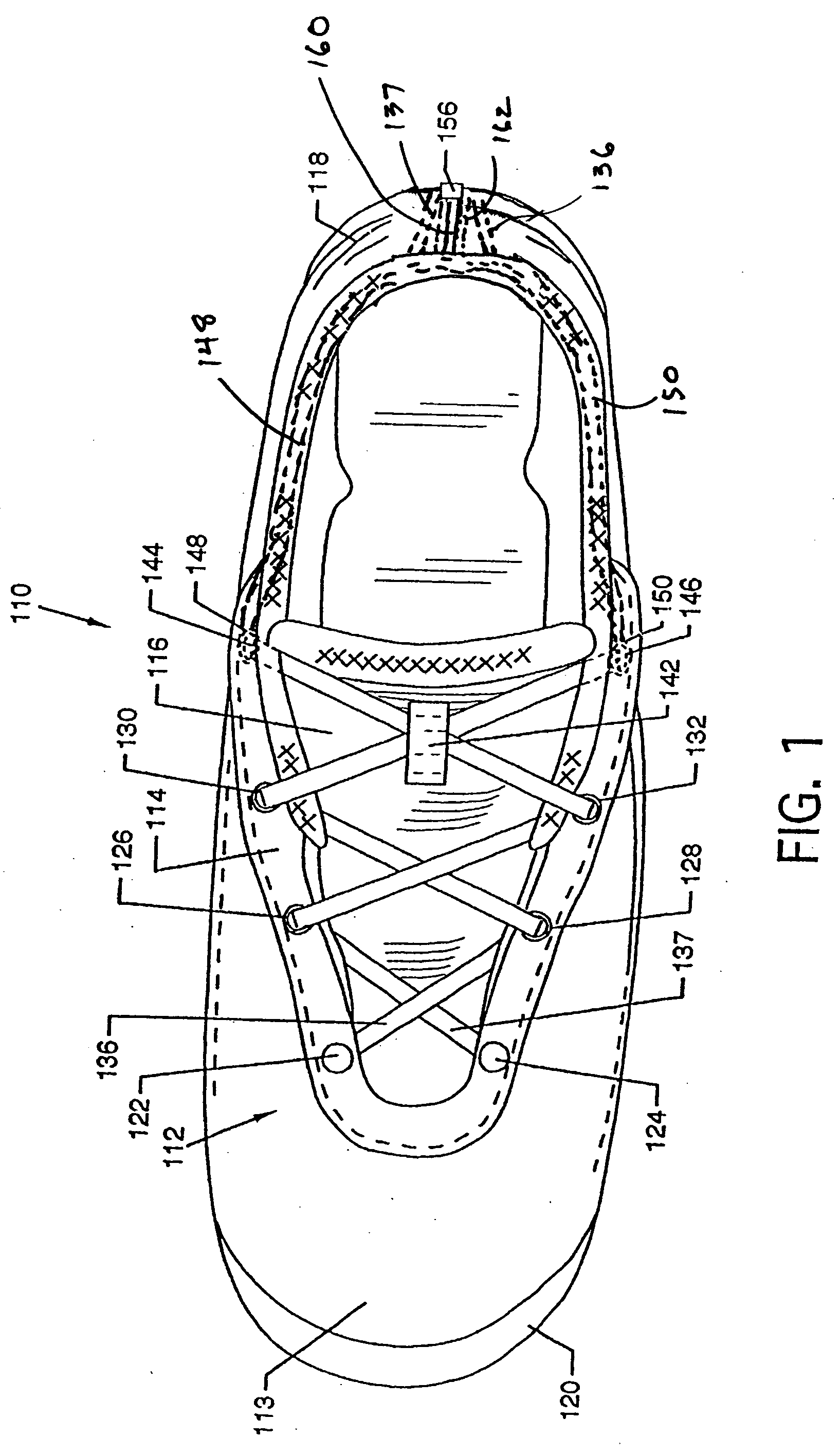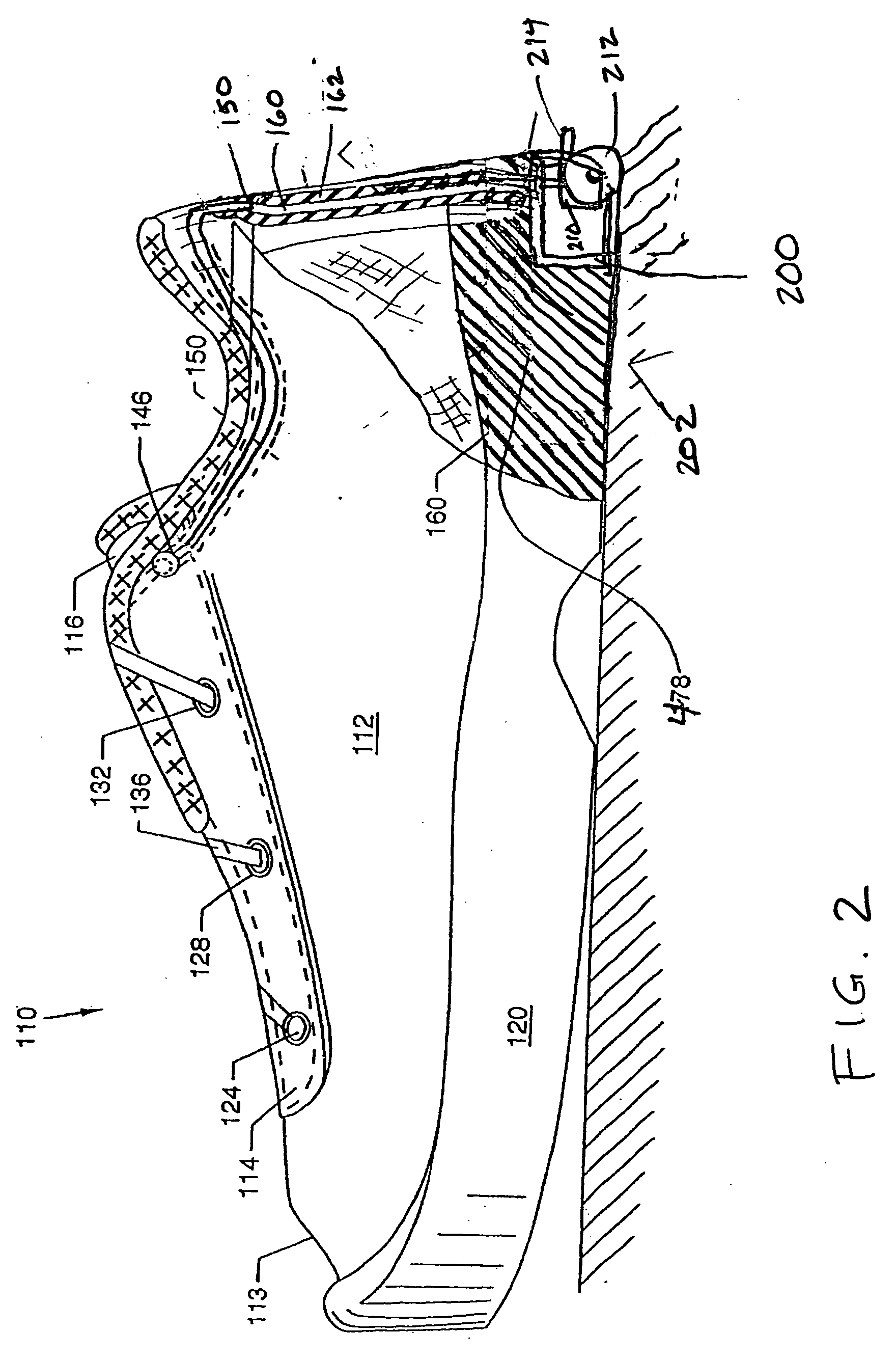Automated tightening shoe
- Summary
- Abstract
- Description
- Claims
- Application Information
AI Technical Summary
Benefits of technology
Problems solved by technology
Method used
Image
Examples
case bottom 220
[0045]Case bottom 220 as shown in FIG. 7 is preferably molded from RTP 301 polycarbonate glass fiber 10% or functionally equivalent material. Extending from its ends are ears 250 and 252 having threaded screw holes 254 and 256. Case bottom 220 features cut-away portion 260 for accommodating actuator wheel 212. Actuator wheel 212 must be cable of rotating freely without rubbing against case bottom 220. Shoulder surfaces 262 and 263 defined by indents 264 and 265 provide a bearing surface for the ends of axles 242 and 244 and cooperate with case top 222 to secure shaft 224 within the housing provided by case bottom 220 and case top 222. Shoulders 270a, 270b, 270c, and 270d provide additional means of support for the axles 242 and 244. Wells 272 and 274 in case bottom 220 accommodate ratchet wheels 240 and 256 of shaft assembly 240. Finally wells 276 and 278 accommodate engagement cables 190 and 192 as they are wound around axles 242 and 244.
[0046]The underneath side of case top 222 is...
case cap 230
[0051]Case cap 230 is shown in greater detail in FIG. 12. Molded preferably from RTP 301 polycarbonate glass fiber 10% or functionally equivalent material, it features posts 246 and 248 boring through holes 250 and 252, so that screws 232 and 233 can be used to mount case cap 230 to case bottom 220 using screw holes 254 and 256 (see FIG. 7). Axle pegs 316 and 318 of release lever 214 are trapped between indents 260 and 262 of case cap 230 (FIG. 12) and indents 322 and 324 of case top 222, so that release lever 214 may pivot within the automated tightening mechanism. Shoulder 264 along the interior surface of case cap 230 provides an abutment surface for bearing portion 230 of torsion spring 236. Instead of screws, other appropriate fastening means, such as glue or sonic welding may be employed to secure the housing parts of the automated tightening mechanism together.
[0052]In operation, the wearer will position his foot so that actuator wheel 212 extending from the rear of the shoe ...
embodiment 210
[0054]The automated tightening mechanism 210 of the present invention is simpler in design than other devices known within the industry. Thus, there are fewer parts to assemble during shoe manufacture and to break down during usage of the shoe. Another substantial advantage of the automated tightening mechanism embodiment 210 of the present invention is that shoe laces 136 and 137 and their associated guide tubes may be threaded down the heel portion of the shoe upper, instead of diagonally through the medial and lateral uppers. This feature greatly simplifies manufacture of shoe 110. Moreover, by locating automated tightening mechanism 210 closer to the heel within shoe sole 120, a smaller housing chamber 200 may be used, and the unit may more easily be inserted and glued into a smaller recess within the shoe sole during manufacture.
[0055]Wheel actuator 212 may be any size in diameter as long as it can extend from the shoe sole without interfering with the normal walking or running...
PUM
 Login to View More
Login to View More Abstract
Description
Claims
Application Information
 Login to View More
Login to View More - R&D
- Intellectual Property
- Life Sciences
- Materials
- Tech Scout
- Unparalleled Data Quality
- Higher Quality Content
- 60% Fewer Hallucinations
Browse by: Latest US Patents, China's latest patents, Technical Efficacy Thesaurus, Application Domain, Technology Topic, Popular Technical Reports.
© 2025 PatSnap. All rights reserved.Legal|Privacy policy|Modern Slavery Act Transparency Statement|Sitemap|About US| Contact US: help@patsnap.com



